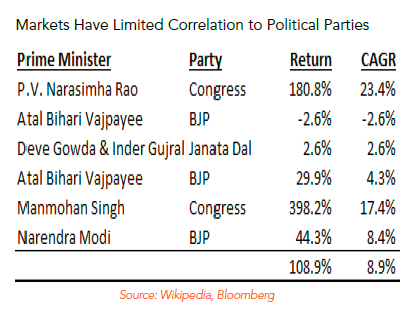
Investment Outlook , Published Feb 17, 2019

Sunil Sharma
CIO at Sanctum Wealth Management.In 2018, we were advising investors to cut back on equity allocations. In contrast, as we head into 2019, the macro picture looks favourable for equities.
Overview
Elections, fiscal stimulus, the Fed and U.S. China trade war are likely to garner short term focus, but lower crude, low inflation, accommodative central banks, structural reforms, a resurgent technology sector, rising consumption and rising domestic flows remain key underpinnings that will drive India’s economic growth.
We live in an age
of privilege, where
investors have
access to large
amounts of information.
The other p/b ratio – price to brent
Over the past two decades, bottoms in crude oil have coincided with subsequently strong
returns in Indian equities. With the news of a doubling of reserves in the Permian Basin, and
expectations of meaningful supply coming on in late 2019, Brent crude prices have come
down 26% from the peak. Longer term, the onset of EVs will further impede demand. Benign
crude prices bode well for India’s fiscal situation. The Price to Brent ratio suggests a favourable
environment for equities ahead.
 Strong FII selling normally precedes good years
We experienced the largest FII selling in India since 2008 last year in equities. FIIs were big
sellers in 2008, 2011, 2013, and 2015. In each instance, FIIs returned to the India market.
What followed in each instance were good years in the markets.
Strong FII selling normally precedes good years
We experienced the largest FII selling in India since 2008 last year in equities. FIIs were big
sellers in 2008, 2011, 2013, and 2015. In each instance, FIIs returned to the India market.
What followed in each instance were good years in the markets.

 Accommodative central bankers
A neutral Fed, a stabilising Fed Balance
Sheet and an accommodative RBI add to
our positive macro outlook. Accommodative
RBI policy starting in late 2001, late
2008, early 2012, and early 2014 was a precursor
to healthy equity markets. The track
record during declining interest rate environments
suggest a similarly favourable
outlook. (See table)
Dominance, vulnerability and cap
Throughout the global economy, big companies
keep getting bigger, more productive,
more profitable, more innovative. Over
time, we expect the largest four names in any
sector to control 90% plus market share. We
are not anywhere close to that situation in
India.
Large caps enjoy increasingly dominant
competitive positioning with the lower cost
of capital, distribution leverage, reputation, and
brand advantages. However, the dominance
can be ephemeral, particularly in
technology; witness Apple, Facebook, and
Tesla. On the other hand, distribution, pricing
power, and branding stand the test of
time; hence Britannia and Hindustan
Unilever sport premium valuations.
While the valuation multiples of mid caps
and small caps have moved to a discount
relative to large caps, the volatility of small
and mid caps has appeared to have caused
a lasting aversion amongst investors. Investors
are increasingly preferring the steadier
returns of larger caps. We note, however,
that forward 3 year expected returns look
attractive for small and mid caps.
The chatter around a yield curve inversion
and U.S. slowdown may also be driving a
preference towards large caps. We favour a
portfolio tilted to large caps, with selective
exposure to high-quality growth mid cap
and small cap in investment portfolios.
Accommodative central bankers
A neutral Fed, a stabilising Fed Balance
Sheet and an accommodative RBI add to
our positive macro outlook. Accommodative
RBI policy starting in late 2001, late
2008, early 2012, and early 2014 was a precursor
to healthy equity markets. The track
record during declining interest rate environments
suggest a similarly favourable
outlook. (See table)
Dominance, vulnerability and cap
Throughout the global economy, big companies
keep getting bigger, more productive,
more profitable, more innovative. Over
time, we expect the largest four names in any
sector to control 90% plus market share. We
are not anywhere close to that situation in
India.
Large caps enjoy increasingly dominant
competitive positioning with the lower cost
of capital, distribution leverage, reputation, and
brand advantages. However, the dominance
can be ephemeral, particularly in
technology; witness Apple, Facebook, and
Tesla. On the other hand, distribution, pricing
power, and branding stand the test of
time; hence Britannia and Hindustan
Unilever sport premium valuations.
While the valuation multiples of mid caps
and small caps have moved to a discount
relative to large caps, the volatility of small
and mid caps has appeared to have caused
a lasting aversion amongst investors. Investors
are increasingly preferring the steadier
returns of larger caps. We note, however,
that forward 3 year expected returns look
attractive for small and mid caps.
The chatter around a yield curve inversion
and U.S. slowdown may also be driving a
preference towards large caps. We favour a
portfolio tilted to large caps, with selective
exposure to high-quality growth mid cap
and small cap in investment portfolios.
 Domestic over global growth
The shift of growth to Asia is unfolding along
expected lines. Germany, France and the U.K.
are making way for India and Indonesia in the
top 10 economies list. EM countries will
account for roughly 50% of global GDP by
2030. As emerging markets develop, the
nature of growth will remain domestic and
consumer driven. The growth of world population
by 750 million, nearly all of it originating
in emerging economies, will account for
about one-quarter of the rise in GDP.
Increased productivity will generate the rest.
This bodes well for Asia, India and domestic-
focused investments.
Equities
The macro picture looks fairly good heading
into 2019 for Indian equities, buffeted by domestic flows, declining rates, low inflation,
lower crude, and accommodative bank
policy.
There remains an excess of capital chasing
fewer attractive opportunities. The U.S. has
$37 trillion in assets under management.
India’s is a fraction of that, and India’s
market cap is less than 2% of the global
market cap. Domestically, substantial capital
sits on the side-lines. Global economic
growth slowing remains a risk to our outlook,
as do elections and credit stress.
Interestingly, the data on equity performance
during various political regimes
clearly demonstrates that the equity markets
have little if any direct correlation to the
political party in power.
At some point, a divergence between our
markets and developed markets is inevitable.
Domestic over global growth
The shift of growth to Asia is unfolding along
expected lines. Germany, France and the U.K.
are making way for India and Indonesia in the
top 10 economies list. EM countries will
account for roughly 50% of global GDP by
2030. As emerging markets develop, the
nature of growth will remain domestic and
consumer driven. The growth of world population
by 750 million, nearly all of it originating
in emerging economies, will account for
about one-quarter of the rise in GDP.
Increased productivity will generate the rest.
This bodes well for Asia, India and domestic-
focused investments.
Equities
The macro picture looks fairly good heading
into 2019 for Indian equities, buffeted by domestic flows, declining rates, low inflation,
lower crude, and accommodative bank
policy.
There remains an excess of capital chasing
fewer attractive opportunities. The U.S. has
$37 trillion in assets under management.
India’s is a fraction of that, and India’s
market cap is less than 2% of the global
market cap. Domestically, substantial capital
sits on the side-lines. Global economic
growth slowing remains a risk to our outlook,
as do elections and credit stress.
Interestingly, the data on equity performance
during various political regimes
clearly demonstrates that the equity markets
have little if any direct correlation to the
political party in power.
At some point, a divergence between our
markets and developed markets is inevitable.

Source: IMF Data Mapper
Last year, we were advising investors to trim equity allocations and be weary of over-exuberance. Today, recognising year-end forecasts are fraught with risk, we are of the view that the macro environment for equities is favourable. In the final analysis, anything meaningful that one wants to accomplish in life and investing takes time and rarely is it easy. Extending time horizons and accepting volatility as the price of admission tilts the odds in one’s favour. Amazon built great wealth for investors, but along the way, there were 5 painful 25-30% corrections. There is likely to be volatility in the beginning of the year as uncertainties remain front and center. Our advice remains simple: align with trusted, competent, service providers, outsource or automate as much as possible, because time is the only commodity that cannot be purchased. Despite their billions, none of us would trade places with Warren Buffett or Rupert Murdoch.There is likely to be volatility in the beginning of the year as uncertainties remain front and center.

 Fixed Income
Global macro conditions remain fairly
favourable, with low crude, low inflation
and accommodative central bank policy
favouring a downward bias on interest
rates. Our forward expectation on crude
pricing is close to current levels, but with a
fairly wide range of deviation. Elections
have brought forth populist announcements
as expected. These represent a risk to the
debt outlook and could exert upward
pressure on rates.
Following in the wisdom of Winston
Churchill, the IL&FS crisis is certainly a good
crisis and does not appear to have gone to
waste. Its after-effects are resonating into
the New Year. Governance, promoter
integrity and those familiar enemies of
business continuity – greed and leverage –
have come to the fore. In the big picture, a
healthy cleansing is underway and the
system should emerge stronger.
In the shorter term, however, these players
are facing challenges in rolling over
maturities and this could potentially impact
debt mutual fund returns. Traditionally,
credit managers have a reputation for deep
analysis and strong due diligence. It is
however, becoming abundantly evident
that many debt fund managers have not
lived up to their fiduciary responsibilities as
responsible allocators of capital that are
supposed to prioritize the most
fundamental notion of safety of principal.
The market will exact a price from those
found lacking, and separate the men from
the boys.
An annual forecast on interest rates is
fraught with a fair bit of risk and uncertainty,
and this year is no exception. With benign
longer term expectations on crude, global
inflation and high domestic real rates, an
argument can be made for a downward
drift on interest rates longer term.
However, uncertainties domestically need
to play out, and worsening credit
conditions remain a risk in the near term
that must be acknowledged. In such a
scenario, we favour the short end of the
curve, higher rated, clean credit, short
duration until risk is clearly priced in and
clarified. We also prefer exposure via
principal protected structured strategies
with upside participation.
Fixed Income
Global macro conditions remain fairly
favourable, with low crude, low inflation
and accommodative central bank policy
favouring a downward bias on interest
rates. Our forward expectation on crude
pricing is close to current levels, but with a
fairly wide range of deviation. Elections
have brought forth populist announcements
as expected. These represent a risk to the
debt outlook and could exert upward
pressure on rates.
Following in the wisdom of Winston
Churchill, the IL&FS crisis is certainly a good
crisis and does not appear to have gone to
waste. Its after-effects are resonating into
the New Year. Governance, promoter
integrity and those familiar enemies of
business continuity – greed and leverage –
have come to the fore. In the big picture, a
healthy cleansing is underway and the
system should emerge stronger.
In the shorter term, however, these players
are facing challenges in rolling over
maturities and this could potentially impact
debt mutual fund returns. Traditionally,
credit managers have a reputation for deep
analysis and strong due diligence. It is
however, becoming abundantly evident
that many debt fund managers have not
lived up to their fiduciary responsibilities as
responsible allocators of capital that are
supposed to prioritize the most
fundamental notion of safety of principal.
The market will exact a price from those
found lacking, and separate the men from
the boys.
An annual forecast on interest rates is
fraught with a fair bit of risk and uncertainty,
and this year is no exception. With benign
longer term expectations on crude, global
inflation and high domestic real rates, an
argument can be made for a downward
drift on interest rates longer term.
However, uncertainties domestically need
to play out, and worsening credit
conditions remain a risk in the near term
that must be acknowledged. In such a
scenario, we favour the short end of the
curve, higher rated, clean credit, short
duration until risk is clearly priced in and
clarified. We also prefer exposure via
principal protected structured strategies
with upside participation.
An annual forecast on
interest rates is
fraught with a fair bit
of risk and
uncertainty, and this
year is no exception.
Gold
Gold has broken out of its trading range
recently, and deserves an allocation in
investor portfolios. Should the macro fundamental
picture change, we would consider
a review of our allocations.
Sectoral Outlook
Consumption remains our key focus area,
poised to benefit from government
largesse. We continue to like financials in
the current stage of the business cycle, particularly
private and corporate banks. The
Technology sector appears to have successfully
transitioned to digital transformation
from the days of BPO, and technology
remains fairly priced. We remain interested
in automation and productivity improvement.
With 2008 fresh in the minds of most investors,
risk-reducing behavioural changes may
have made the system more stable and a
severe crisis less likely. When everyone is
too afraid to take big risks, it is hard to get a
truly threatening bubble underway. As we
move to $2000 per capita annual income,
consumption is likely to grow. Of the next
billion customers, a good-sized chunk will
originate out of India.
 Download Investment Outlook 2019
Download Investment Outlook 2018
Download Investment Outlook 2017
Download Investment Outlook 2019
Download Investment Outlook 2018
Download Investment Outlook 2017
Investment Outlook 2019